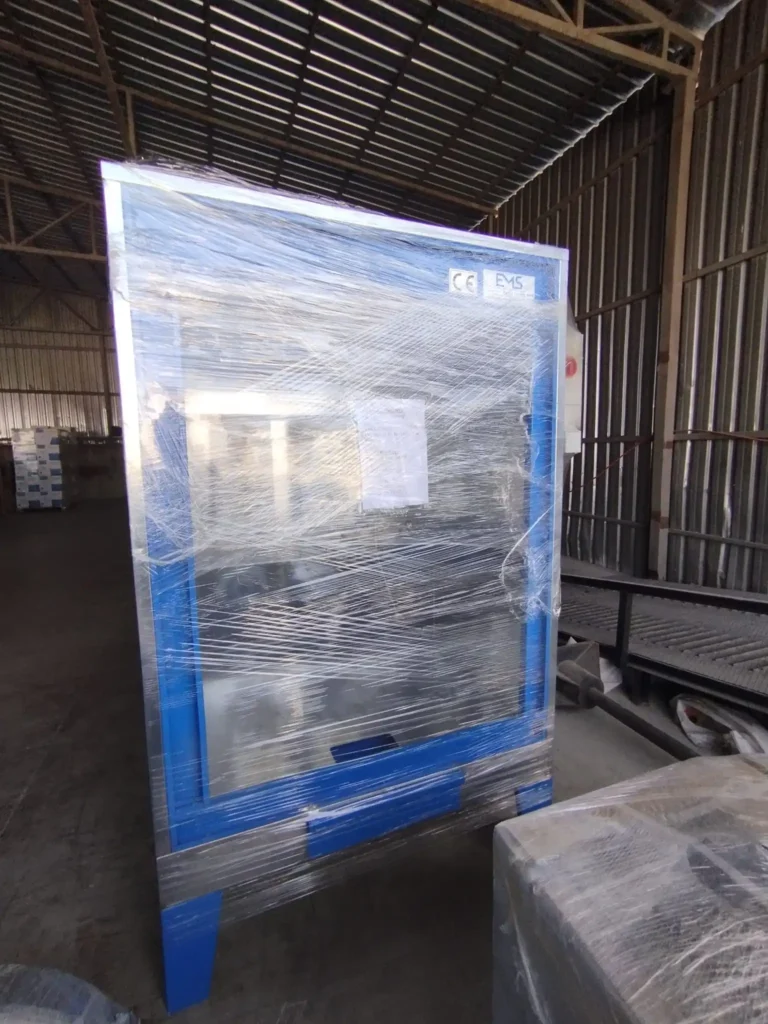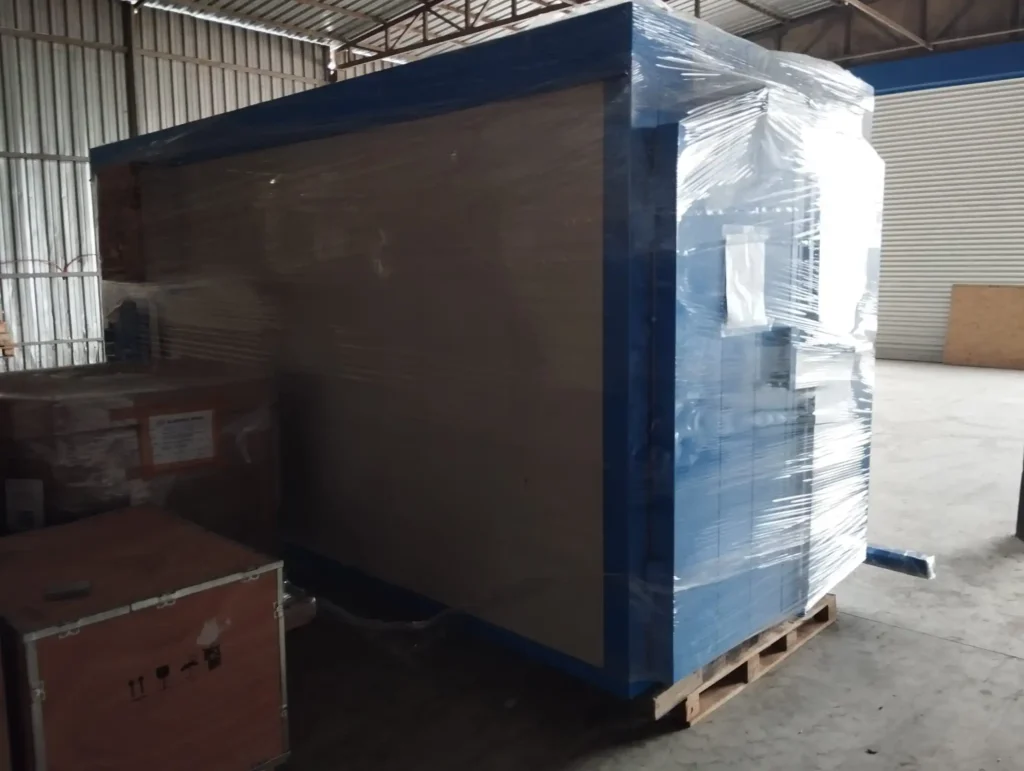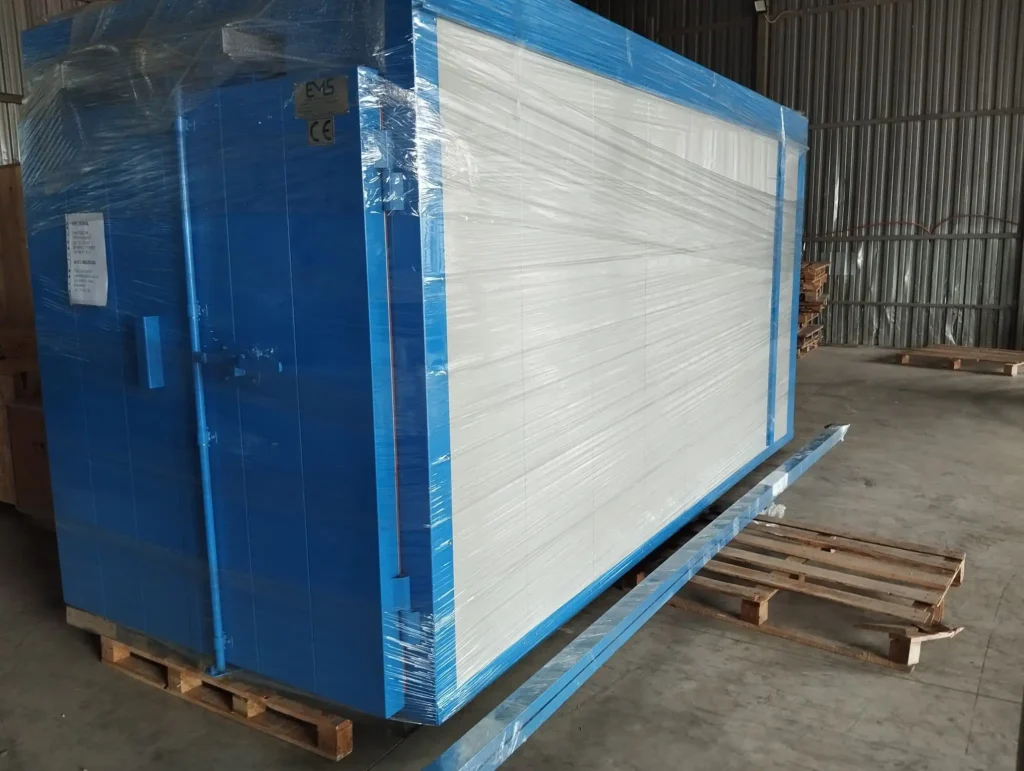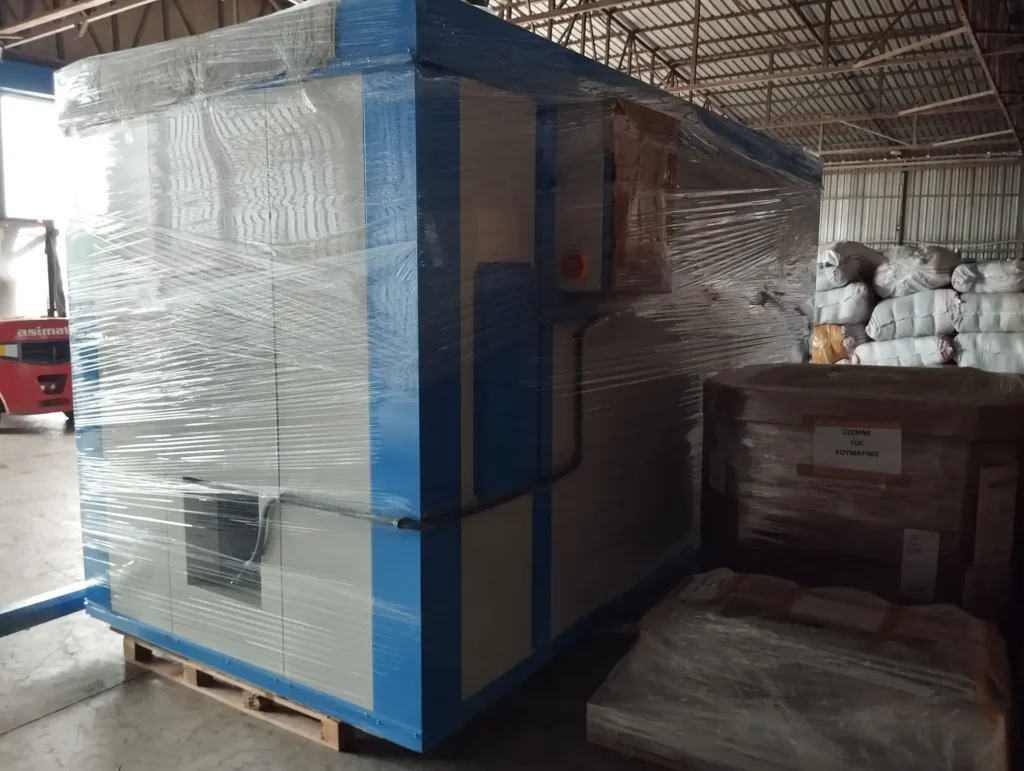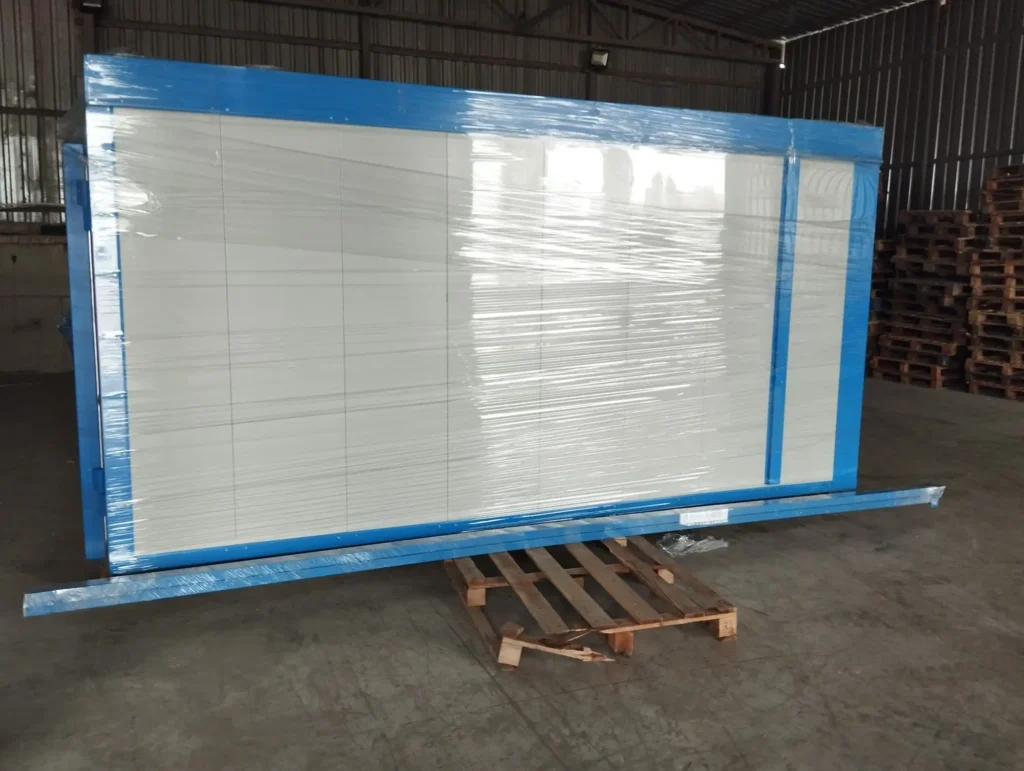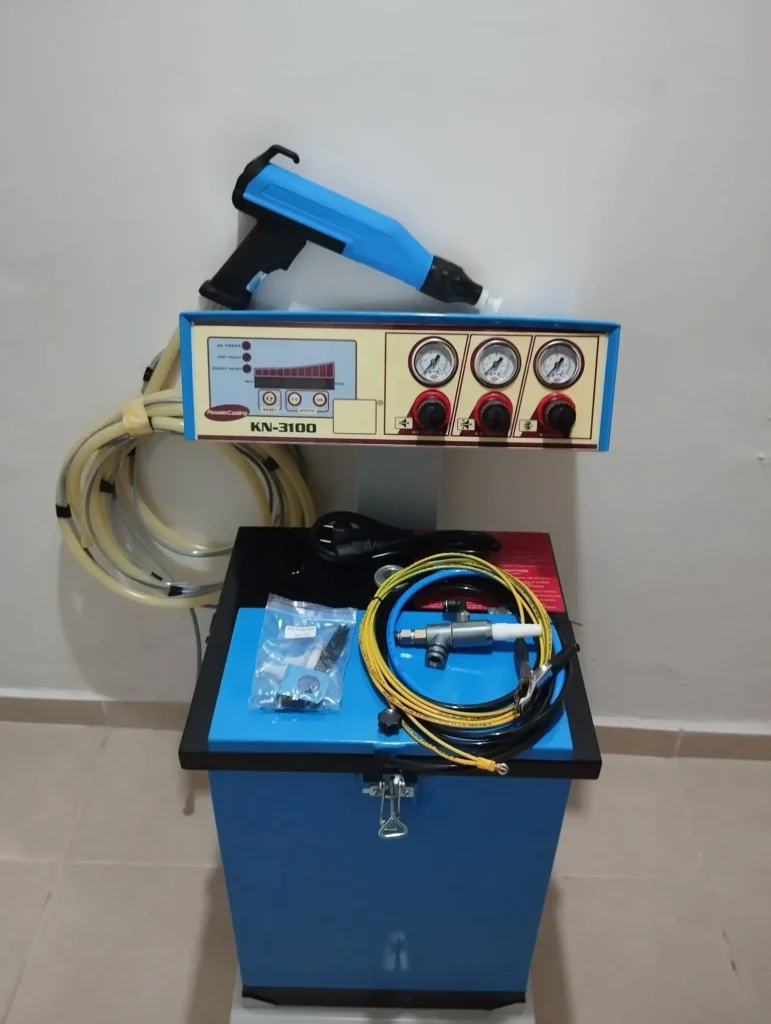
A powder coat gun is a tool used in the powder coating process, which is a method of applying a protective and decorative finish to various materials. Powder coating involves applying a dry powder to a surface and then curing it with heat to create a durable and attractive coating. The powder coat gun is a crucial component in this process.
Best Powder Coat Gun under 1000
Here’s a brief overview of how a powder coat gun works:
- Powder Application: The powder coat gun is used to spray electrostatically charged powder onto the surface of the object being coated. The powder is typically made of finely ground particles of pigment and resin.
- Electrostatic Charging: The gun imparts an electrostatic charge to the powder particles as they are sprayed. This causes the powder to be attracted to the grounded object, creating a uniform and even coating.
- Coating Thickness Control: The powder coat gun allows for control over the amount of powder being applied, helping to achieve the desired thickness of the coating.
- Variety of Nozzles and Settings: Powder coat guns often come with different nozzles and settings to accommodate various types of powder coatings and different application requirements.
- Curing Process: After the powder is applied, the coated object is typically moved to an oven for curing. The heat melts and fuses the powder particles, creating a smooth and durable finish.
There are different types of powder coat guns available, including manual guns for smaller projects and automatic guns for larger-scale production. The choice of gun depends on factors such as the size of the objects being coated, the desired finish, and the production volume.
It’s important to follow safety guidelines and wear protective gear when using powder coat guns, as the powders used in the process can be potentially hazardous if inhaled or if there is skin contact. Additionally, proper ventilation and workspace considerations are essential for a safe powder coating environment.
Electrostatic Spraying in Powder Coat Guns
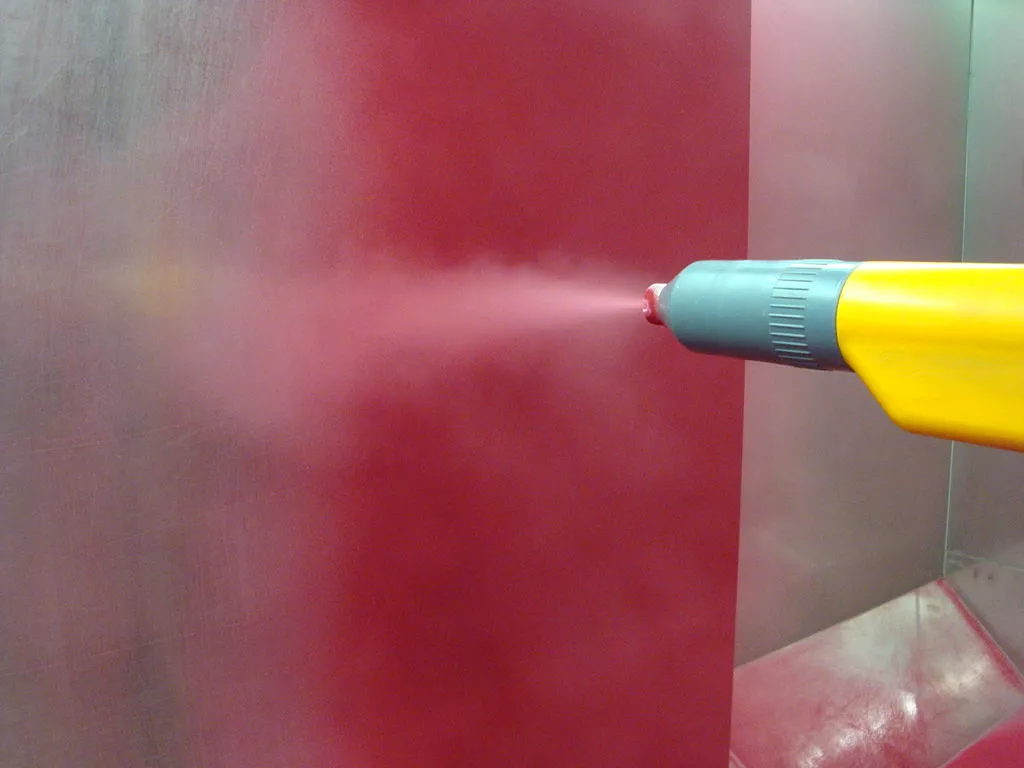
Electrostatic spraying is a fundamental principle in the operation of powder coat guns. This process plays a pivotal role in achieving an even and uniform coating on surfaces. In electrostatic spraying, the powder particles are charged with an electrostatic charge as they are expelled from the gun. This charge is typically imparted to the particles by passing them through an electric field within the gun.
The key advantage of electrostatic spraying is that it creates a strong attraction between the charged powder particles and the grounded object being coated. As the particles are sprayed onto the surface, they are drawn to the object, ensuring comprehensive coverage even on complex shapes and hard-to-reach areas. This electrostatic attraction results in a more efficient and controlled application of the powder.
The electrostatic charging also contributes to minimizing overspray, as the charged particles are directed toward the grounded object rather than dispersing into the air. This not only enhances the efficiency of the coating process but also reduces waste and improves environmental sustainability.
Precision in electrostatic spraying is crucial for achieving the desired coating thickness and appearance. Powder coat guns are designed with advanced technologies to control and adjust the electrostatic charge, ensuring consistent and reliable performance in various coating applications. Overall, electrostatic spraying is a cornerstone of the powder coating process, enabling high-quality, durable, and aesthetically pleasing finishes on a wide range of materials and products.
Powder Coating Equipment

Powder coating equipment encompasses a range of tools and machinery designed to facilitate the application of dry powder coatings onto various surfaces. The equipment involved in the powder coating process includes not only the powder coat gun but also other essential components that contribute to the efficiency and effectiveness of the overall coating operation.
One of the primary components of powder coating equipment is the powder delivery system. This system typically consists of a powder feeder or hopper that stores the dry powder. The powder is then transported to the powder coat gun through a series of hoses or tubes. The delivery system ensures a continuous and controlled supply of powder for the coating process.
The control unit is another integral part of the equipment, providing operators with the ability to adjust and regulate various parameters such as powder flow rate, electrostatic charge, and air pressure. Advanced control units may feature programmable settings, allowing for precise customization based on specific coating requirements.
In addition to the powder coat gun and control unit, the powder coating equipment often includes a curing oven. The curing process is essential for melting and fusing the powder particles to create a durable and resilient coating. Curing ovens are designed to maintain specific temperature profiles, ensuring the proper curing of the powder coating without compromising the integrity of the coated object.
Powder coating equipment is available in various configurations to accommodate different application needs, from manual guns for smaller-scale projects to automated systems for high-volume production. The selection of equipment depends on factors such as the size and complexity of the objects being coated, the desired coating quality, and the production volume. Overall, efficient and well-maintained powder coating equipment is critical for achieving consistent and high-quality finishes across diverse applications.
Coating Thickness Control in Powder Coat Guns

Coating thickness control is a crucial aspect of the powder coating process, and powder coat guns are equipped with features to precisely manage the thickness of the applied coating. Achieving the correct coating thickness is essential for meeting performance, durability, and aesthetic requirements.
One method employed in coating thickness control is the adjustment of powder flow rate. Powder coat guns are designed with settings that allow operators to regulate the amount of powder being sprayed onto the surface. This control is critical for achieving uniform coverage and preventing issues such as overcoating or insufficient coating thickness.
Furthermore, some advanced powder coat guns incorporate feedback mechanisms and monitoring systems. These systems provide real-time data on the coating thickness during the application process. Operators can use this information to make on-the-fly adjustments to ensure that the coating meets the specified thickness requirements.
Another factor influencing coating thickness is the distance between the powder coat gun and the object being coated. Powder coat guns often have adjustable nozzles or spray patterns that allow operators to control the spray cone and, consequently, the coverage area. Proper positioning and distance control contribute to consistent coating thickness across the entire surface.
Quality control measures may include periodic inspections using tools such as coating thickness gauges. These gauges help verify that the applied coating meets the required specifications. Regular calibration of the powder coat gun and associated equipment is essential to maintain accuracy in coating thickness control.
In summary, coating thickness control is a multifaceted process involving the regulation of powder flow, nozzle adjustments, real-time monitoring, and quality assurance measures. The precision achieved through these control mechanisms ensures that powder coating applications meet industry standards and specific project requirements.
Curing Oven in Powder Coating Process

The curing oven is a critical component in the powder coating process, playing a pivotal role in transforming the applied dry powder into a durable and resilient finish on the coated object. The curing stage is essential for achieving the desired physical and chemical properties of the powder coating, including adhesion, hardness, and resistance to environmental factors.
After the powder is applied using the powder coat gun and adheres to the object’s surface through electrostatic attraction, the coated object is moved to the curing oven. The curing process typically involves exposing the coated object to elevated temperatures for a specified duration. The heat applied during curing causes the powder particles to melt and fuse, forming a continuous and robust coating.
The curing oven is designed to provide controlled heating, ensuring that the powder coating cures uniformly across the entire surface of the object. The temperature and duration of the curing process are critical parameters and may vary depending on the type of powder coating material used, the substrate material, and the desired coating properties.
During the curing stage, the powder coating undergoes several transformations. The powder particles first melt, allowing the coating to flow and level, creating a smooth and even finish. As the coating continues to cure, it undergoes a chemical cross-linking process, enhancing its adhesion to the substrate and contributing to its overall durability.
Curing ovens are often equipped with advanced features such as temperature control systems, airflow management, and programmable settings to ensure precise and consistent curing conditions. Properly cured powder coatings exhibit excellent resistance to chemicals, UV radiation, and abrasion, making them suitable for a wide range of applications.
In summary, the curing oven is a crucial element in the powder coating process, finalizing the transformation of the applied powder into a robust and high-quality coating. The controlled heat application ensures that the coated objects meet performance standards and exhibit the desired physical and chemical characteristics.
Finishing Process in Powder Coating:
The finishing process in powder coating encompasses the steps taken after the application and curing of the powder to ensure that the coated object meets the desired aesthetic and functional requirements. This phase involves a combination of quality control measures, surface preparation, and, in some cases, additional treatments to enhance the final appearance and performance of the coating.
- Inspection and Quality Control: After the curing process, the coated objects undergo thorough inspection to assess the overall quality of the powder coating. Inspections may include checks for uniformity, adhesion, color consistency, and the absence of defects such as bubbles or uneven texture. Quality control measures are essential to identify any issues that may require corrective action.
- Surface Preparation: In some cases, the coated objects may undergo additional surface preparation steps to address any imperfections or irregularities. This can include processes such as sanding, polishing, or cleaning to achieve the desired surface smoothness and finish.
- Color Matching and Customization: Powder coating allows for a wide range of color options, and the finishing process may involve color matching to ensure consistency across multiple coated objects. Customization options may also include the addition of metallic or textured finishes to achieve specific visual effects.
- Protective Coatings: Depending on the application and environmental conditions, a protective clear coat may be applied as part of the finishing process. This additional layer can enhance the durability of the powder coating, providing resistance to scratches, chemicals, and UV radiation.
- Packaging and Shipping: Once the finishing process is complete, the coated objects are carefully packaged to prevent damage during transportation. Proper packaging is crucial to preserving the integrity of the powder coating and ensuring that the coated items reach their destination in pristine condition.
- Documentation and Traceability: In industrial or large-scale applications, documentation of the powder coating process, including the type of powder used, curing specifications, and any additional treatments, may be important for quality control and traceability.
The finishing process is a comprehensive stage that not only addresses the functional aspects of the powder coating but also focuses on the visual appeal and long-term durability of the coated objects. Attention to detail in this phase contributes to the overall success of powder coating applications in various industries.
Powder Coat Application Process
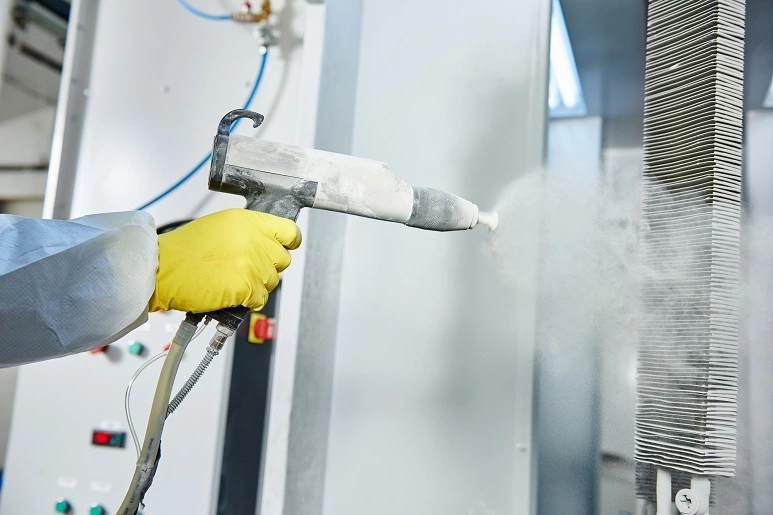
The powder coat application process is a crucial step in achieving a durable, high-quality finish on various surfaces. This process involves the use of a powder coat gun to apply a dry powder coating onto the object being coated. Here’s a detailed explanation of the powder coat application process:
- Surface Preparation: Before the powder coating process begins, the surface of the object must be properly prepared. This involves cleaning the substrate to remove any contaminants, such as oil, grease, or rust. Proper surface preparation ensures optimal adhesion of the powder coating.
- Powder Coat Gun Setup: The powder coat gun is equipped with various settings and adjustments to control the application process. This includes the electrostatic charge settings, powder flow rate, and spray pattern adjustments. The gun is connected to the powder supply system, which typically consists of a powder feeder or hopper.
- Electrostatic Charging: As the dry powder is fed into the powder coat gun, it passes through an electrostatic field that imparts a positive charge to the powder particles. The gun nozzle then sprays the charged powder onto the grounded object, creating an electrostatic attraction that ensures even coverage.
- Spraying Technique: The operator uses the powder coat gun to apply the powder in a controlled manner. The spray technique involves moving the gun in a consistent and overlapping pattern to achieve uniform coverage. The adjustable nozzle allows for changes in spray pattern and width, facilitating precise application.
- Powder Adhesion: The electrostatically charged powder adheres to the grounded object, covering its entire surface. The charged particles are attracted to the grounded substrate, creating a coating that is not only visually appealing but also tightly bonded for enhanced durability.
- Excess Powder Recovery: During the application process, some powder may not adhere to the object and is considered overspray. To minimize waste, powder recovery systems are often used to collect and recycle the excess powder, making the process more efficient and environmentally friendly.
- Inspection and Correction: After the powder is applied, the coated object undergoes inspection to identify any defects or irregularities. If necessary, corrections can be made by reapplying powder to specific areas before the curing process.
- Transfer Efficiency: Powder coat guns are designed to maximize transfer efficiency, which is the percentage of powder that adheres to the object compared to the total amount sprayed. Higher transfer efficiency contributes to cost-effectiveness and reduces waste.
In summary, the powder coat application process involves precise control of the powder coat gun, electrostatic charging, and skilled spraying techniques to achieve an even, durable, and visually appealing coating on a wide range of materials and products.
Nozzle Technology in Powder Coat Guns
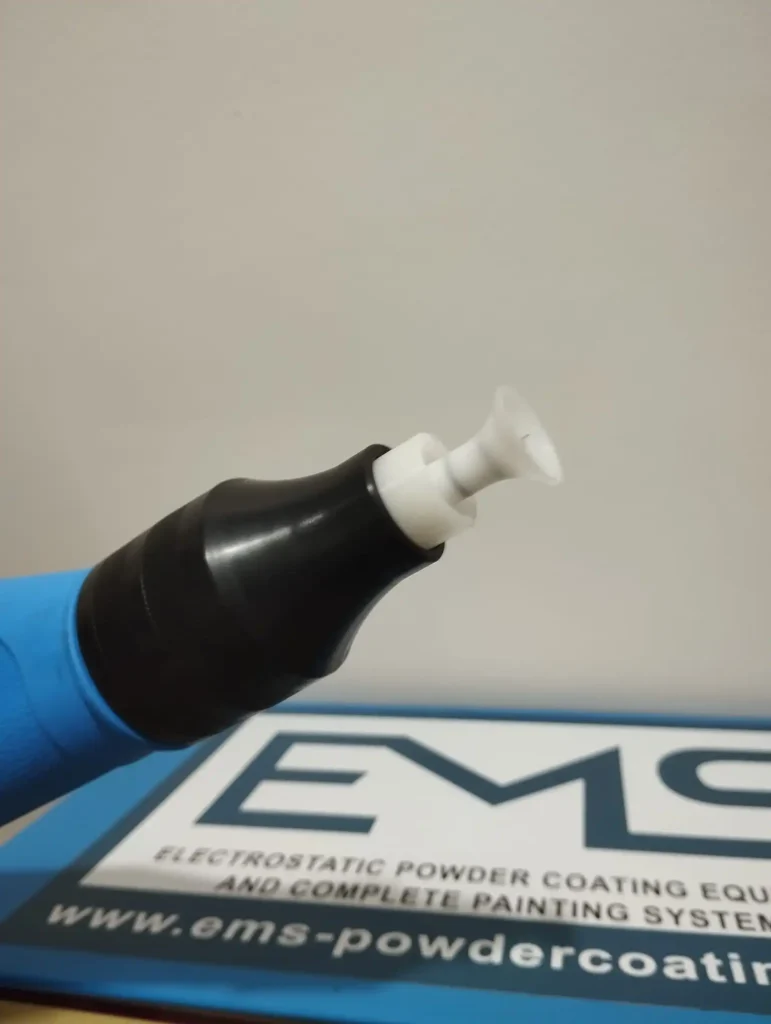
Nozzle technology plays a pivotal role in the efficiency and effectiveness of powder coat guns, influencing factors such as spray pattern, coating thickness, and overall application performance. The nozzle is a critical component that determines how the electrostatically charged powder particles are dispersed onto the object being coated. Here’s an in-depth look at the importance of nozzle technology:
- Spray Pattern: Nozzle design significantly influences the spray pattern, which refers to the shape and distribution of the powder as it is expelled from the gun. Different applications may require specific spray patterns, and adjustable nozzles allow operators to tailor the pattern to suit the size and shape of the objects being coated.
- Pattern Width and Shape Adjustability: Advanced powder coat guns feature nozzles with adjustable widths and shapes. This adaptability enables operators to customize the spray pattern according to the contours of the object, ensuring comprehensive coverage and uniform coating thickness, even on complex surfaces.
- Precision Control: Nozzle technology contributes to precise control over powder application. This includes the ability to vary the powder flow rate and achieve consistent coating thickness across the entire surface. Precision is crucial in meeting quality standards and minimizing material waste.
- Efficient Transfer Efficiency: Nozzles are designed to optimize the transfer efficiency of the powder from the gun to the object. A well-designed nozzle ensures that a high percentage of the sprayed powder adheres to the substrate, minimizing overspray and reducing the amount of waste generated during the coating process.
- Material Compatibility: Different powder coatings may have varying particle sizes and flow characteristics. Nozzle technology is often tailored to accommodate a range of powder types, ensuring compatibility and consistent performance across diverse coating materials.
- Durability and Maintenance: Nozzles are subject to wear and tear over time due to the abrasive nature of powders. The durability of nozzle materials and design considerations for ease of maintenance are critical factors. Some nozzles are designed for quick and straightforward cleaning or replacement, minimizing downtime in production environments.
- Anti-Corona Features: To prevent issues like the “corona effect,” where excessive electrostatic charge causes powder particles to repel each other, modern nozzle designs may incorporate features to mitigate this phenomenon. Anti-corona features contribute to a more controlled and stable application process.
- Compatibility with Automated Systems: In automated powder coating systems, the compatibility of nozzles with robotic or conveyor systems is essential. Nozzle technology that integrates seamlessly with automation enhances the efficiency and speed of large-scale production processes.
In conclusion, nozzle technology is a critical aspect of powder coat guns, influencing the precision, efficiency, and versatility of the powder coating application process. Advances in nozzle design contribute to improved coating quality, reduced waste, and enhanced overall performance in various industrial and manufacturing applications.
Powder Coating Gun Settings
Powder coating gun settings are crucial parameters that operators can adjust to achieve optimal performance in the application of powder coatings. These settings allow for fine-tuning of various aspects of the powder coat gun’s operation, ensuring precise control over the coating process. Here’s an in-depth exploration of key powder coating gun settings:
- Powder Flow Rate: One of the fundamental settings is the powder flow rate, which controls the amount of powder being dispensed by the gun. Operators can adjust this setting to achieve the desired coating thickness, and it plays a critical role in overall efficiency and material utilization.
- Electrostatic Charge: The electrostatic charge setting determines the level of charge imparted to the powder particles as they are sprayed. Adjusting this setting is essential for achieving proper electrostatic attraction between the powder and the grounded object, ensuring uniform coverage and adhesion.
- Airflow Control: Powder coat guns often feature adjustable airflow settings that control the velocity and pattern of the powder spray. Fine-tuning airflow is crucial for achieving an even coating and can be customized based on the size and shape of the objects being coated.
- Spray Pattern: The spray pattern setting allows operators to modify the shape and width of the powder spray. This setting is particularly important when coating objects with varying geometries, as it enables the adaptation of the spray pattern to cover intricate details or larger surface areas efficiently.
- Gun-to-Object Distance: The distance between the powder coat gun and the object being coated is a critical parameter. Adjusting this distance ensures that the powder particles are applied evenly across the surface. It also influences coating thickness and helps prevent issues such as uneven application or overspray.
- Triggering and Gun Operation: Powder coating guns have triggers or controls that operators use to initiate and stop the spraying process. Understanding how to effectively control the gun during application is crucial for achieving precision and minimizing errors in the coating process.
- Pre-programmed Settings: Advanced powder coat guns may come equipped with pre-programmed settings for specific coating applications. These settings can be customized based on the type of powder, object size, and desired finish. Pre-programmed options enhance efficiency and consistency in large-scale production environments.
- Feedback and Monitoring Systems: Some powder coat guns feature feedback mechanisms or monitoring systems that provide real-time data on the application process. This information allows operators to make on-the-fly adjustments and ensures that the coating meets the required specifications.
Operators need a comprehensive understanding of these powder coating gun settings to achieve optimal results in various coating applications. Regular training and familiarity with the specific characteristics of the powder coating materials used contribute to efficient and precise adjustments of these settings during the coating process.
Durable Finish in Powder Coating
Achieving a durable finish is a primary objective in the powder coating process, and it involves a combination of material selection, application techniques, and curing processes. The durability of a powder-coated finish is essential for ensuring the longevity and performance of coated objects in various environments. Here’s an in-depth exploration of the factors contributing to a durable powder coating finish:
- Powder Coating Material Selection: The choice of powder coating material is fundamental to the durability of the finish. Different powder formulations offer varying levels of resistance to factors such as UV exposure, chemicals, abrasion, and corrosion. Polyester, epoxy, polyurethane, and hybrid powder coatings are among the options, each tailored to specific performance requirements.
- Proper Surface Preparation: Surface preparation before powder coating is a critical step in achieving a durable finish. Cleaning, degreasing, and, if necessary, applying pre-treatments such as phosphate or conversion coatings enhance the adhesion of the powder to the substrate. A well-prepared surface ensures the longevity of the coating by preventing premature delamination or corrosion.
- Even Powder Application: Uniform powder application is essential for creating a durable finish. Powder coat guns, with their adjustable settings and precise control mechanisms, play a key role in achieving even coverage. Proper application ensures that the coating thickness is consistent across the entire surface, contributing to durability.
- Curing Process: The curing or baking process is critical for transforming the applied powder into a durable, cross-linked coating. During curing, the powder particles melt, flow, and chemically bond to form a robust and resilient finish. Proper curing times and temperatures are essential to achieving the desired physical and chemical properties, including hardness, adhesion, and resistance to environmental factors.
- Adhesion and Bonding: The electrostatic attraction created during the powder coating process contributes to strong adhesion between the powder and the substrate. The cured coating forms a molecular bond with the surface, enhancing its durability and preventing issues such as chipping, peeling, or flaking.
- Resistance to Environmental Factors: A durable powder coating should exhibit resistance to environmental factors such as UV radiation, moisture, chemicals, and temperature fluctuations. This resistance ensures that the coated objects maintain their appearance and performance over an extended period, even in challenging conditions.
- Testing and Quality Control: Rigorous testing and quality control measures are employed to assess the durability of powder-coated finishes. Common tests include impact resistance, abrasion resistance, salt spray testing, and accelerated weathering tests. These tests help verify that the coating meets industry standards and can withstand various stresses over time.
- Proper Handling and Packaging: After the coating process is complete, proper handling and packaging are essential to prevent damage to the freshly coated objects. Careful packaging ensures that the powder-coated items reach their destination without compromising the integrity of the finish.
In conclusion, achieving a durable finish in powder coating involves a comprehensive approach, from material selection to application techniques and curing processes. Attention to these factors ensures that powder-coated objects exhibit longevity, resistance to environmental factors, and maintain their aesthetic and functional properties over an extended period.
Safety Precautions in Powder Coating
Ensuring a safe working environment is paramount in any powder coating operation. Powder coating involves the use of fine dry powder particles, and several safety precautions are essential to protect the health of operators, prevent accidents, and maintain overall workplace safety. Here’s an in-depth exploration of key safety precautions in powder coating:
- Personal Protective Equipment (PPE): Operators should wear appropriate PPE to minimize exposure to airborne powder particles and prevent skin contact. This includes safety glasses or goggles, gloves, protective clothing, and respiratory protection such as dust masks or respirators.
- Ventilation Systems: Adequate ventilation is critical in powder coating areas to control airborne particles and ensure a safe working environment. Local exhaust ventilation systems, such as fume hoods or booths, help capture and remove airborne powder, minimizing the risk of inhalation.
- Respiratory Protection: Depending on the type of powder being used, respiratory protection may be necessary. Respirators equipped with filters suitable for particulate matter can protect operators from inhaling fine powder particles. The choice of respiratory protection should be based on a thorough assessment of the specific hazards present.
- Powder Containment: Powder coating operations should be designed to contain the powder and prevent its dispersion into surrounding areas. This includes the use of enclosed spray booths and powder recovery systems to capture overspray and minimize environmental contamination.
- Training and Education: Operators should undergo thorough training on the proper use of powder coating equipment, safety protocols, and emergency procedures. Understanding the potential hazards and knowing how to handle equipment safely contributes to a safer work environment.
- Fire Safety Measures: Powder coatings are typically flammable, and fire safety precautions are crucial. This includes having fire extinguishers readily available, maintaining proper grounding to prevent static electricity, and ensuring that the powder coating area complies with fire safety codes and regulations.
- Handling and Storage: Safe handling and storage of powder coatings are essential. Powder containers should be kept tightly closed when not in use to prevent spills or contamination. Proper labeling of containers with information on the type of powder and any associated hazards is also important.
- Emergency Procedures: Clear and well-communicated emergency procedures should be in place, including protocols for spills, accidents, or exposure incidents. Operators should know how to respond to emergencies promptly and safely.
- Regular Equipment Maintenance: Regular maintenance of powder coating equipment is vital for preventing malfunctions and ensuring safe operation. This includes checking for leaks, inspecting hoses and connections, and promptly addressing any issues to prevent accidents.
- Hazard Communication: Employers should provide clear communication regarding the hazards associated with the specific powder coatings being used. Material Safety Data Sheets (MSDS) or Safety Data Sheets (SDS) should be readily available, detailing information on the composition, hazards, and safe handling of the powder coatings.
By implementing these safety precautions, employers can create a safer working environment for operators involved in powder coating processes, minimizing health risks and promoting overall workplace safety. Regular training, adherence to safety guidelines, and ongoing risk assessments contribute to the effectiveness of these safety measures.
Powder Coating Machinery At Competitive Prices
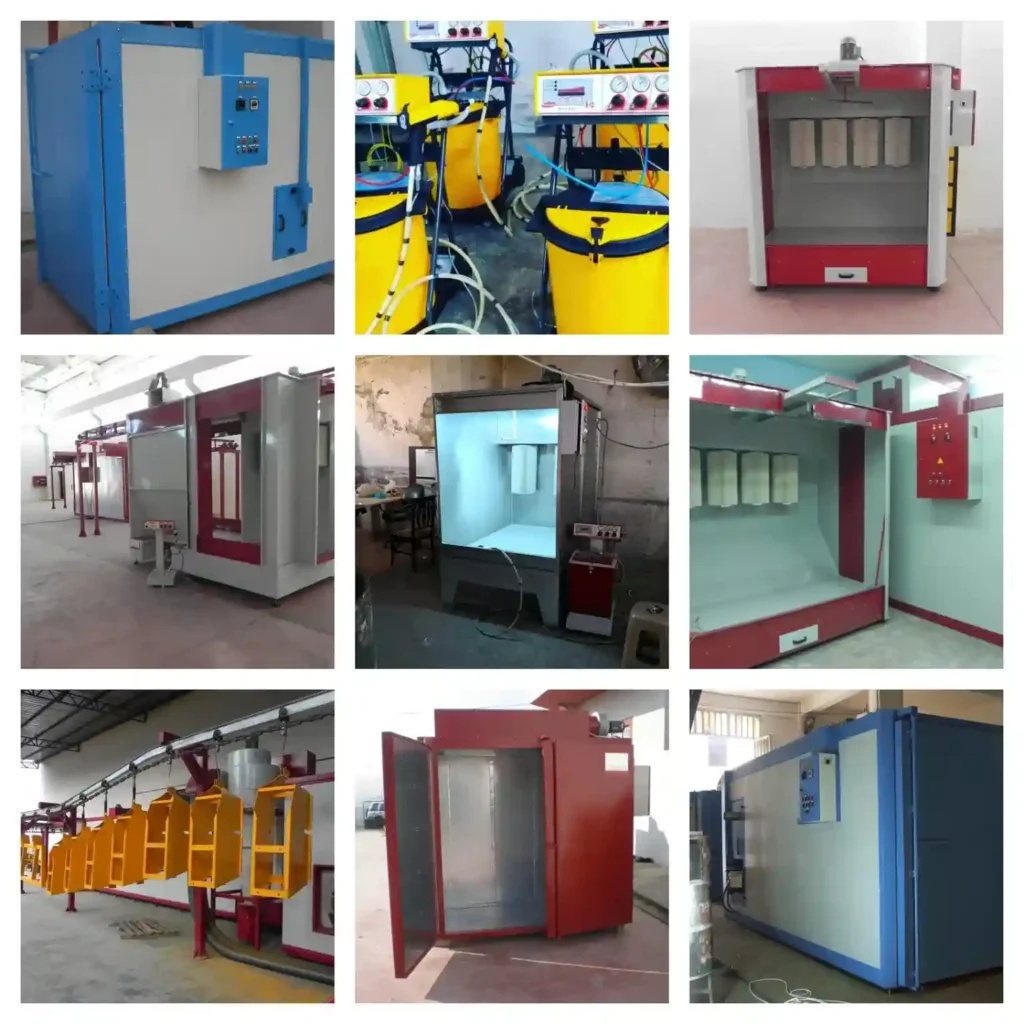
Powder coating equipment is used to apply a thin layer of powder over a metal surface. This type of coating is applied by an electrostatic process and is a very popular method for finishing metal parts.
This type of equipment can be divided into two main categories: automatic and manual. Automatic booths are more popular because they provide better production rates, but they are also more expensive.
A powder booth is an enclosure in which the powder-coating process takes place. Powder-coating equipment includes an oven where the parts are heated to activate the powder, a gun that sprays or brushes on the powder, a conveyor belt that moves parts through the oven, and cartridge-type guns for applying thicker coatings with less overspray.
Powder coating is a technique that is used to provide a finish to metal parts. This technique has been in use for many years and it is still one of the most popular techniques today.
Powder coating equipment consists of booths, ovens, guns, machines, lines and conveyors. A booth can be either automatic or manual. An automatic booth is more expensive than a manual booth but it is also faster and more efficient.
Thermoset powder: Thermoset powders are the most common type of powder coating. They undergo an irreversible chemical reaction during the curing process, forming a hard, crosslinked network that is highly resistant to heat, chemicals, and scratches.
Thermoplastic powder: Thermoplastic powders do not undergo a chemical reaction during the curing process. Instead, they simply melt and fuse together when heated. This makes them less durable than thermoset powders, but they are also more re-flowable, which can be useful for certain applications.
Epoxy powder: Epoxy powders are known for their excellent corrosion resistance and chemical resistance. They are also very hard and durable. However, they can be brittle and are not as UV resistant as some other types of powder coating.
Polyester powder: Polyester powders are the most versatile type of powder coating. They offer a good balance of properties, including durability, corrosion resistance, UV resistance, and chemical resistance. They are also available in a wide range of colors and finishes.
Polyurethane powder: Polyurethane powders are known for their flexibility and toughness. They are also very resistant to abrasion and impact. However, they are not as heat resistant as some other types of powder coating.
Acrylic powder: Acrylic powders are known for their excellent UV resistance and weather resistance. They are also very glossy and have a high scratch resistance. However, they are not as chemically resistant as some other types of powder coating.
Nylon powder: Nylon powders are known for their excellent chemical resistance and abrasion resistance. They are also very flexible and impact resistant. However, they are not as heat resistant as some other types of powder coating.
Fluorocarbon powder: Fluorocarbon powders are known for their excellent chemical resistance, UV resistance, and non-stick properties. They are also very durable and easy to clean. However, they are relatively expensive.
Silica powder: Silica powders are used as fillers and extenders in powder coatings. They can help to improve the adhesion, flow, and leveling of the coating.
Metal flake powder: Metal flake powders are used to create decorative finishes. They can be used to add sparkle, shine, or a metallic look to a powder coating.
Not only do we manufacture our powder coating equipment, we also ship them worldwide to your facility with care
We’re not just the manufacturers of your powder coating equipment, we’re also your worldwide delivery partners.
At EMS Powder Coating Equipment, we understand that getting your powder coating equipment to you quickly and safely is just as important as manufacturing it to the highest standards. That’s why we offer worldwide delivery services to all of our customers.
We work with a network of experienced and reliable shipping partners to ensure that your equipment arrives on time and in perfect condition. We also offer a variety of shipping options to fit your budget and needs.
Whether you need your equipment shipped to a local address or to an international destination, we can help. We’ll work with you to choose the best shipping option for your needs and to keep you updated on the status of your shipment every step of the way.
So when you choose EMS for your powder coating equipment, you’re not just getting the best products on the market, you’re also getting the best possible delivery experience.
Contact us today to learn more about our worldwide delivery services.


